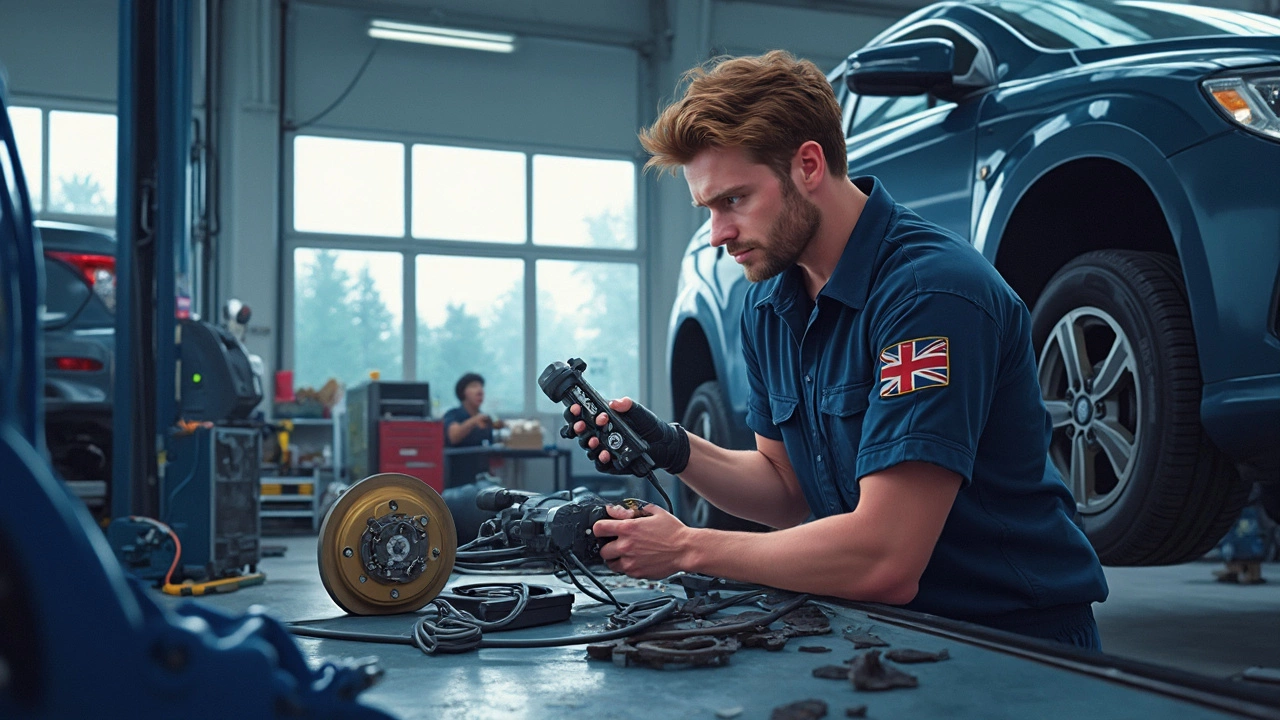So, you're wondering if it's worth replacing your brake pads? Trust me, it's not just about keeping things smooth on the road, it's about safety too. Brake pads are like the unsung heroes in your braking system. They clamp down on the brake rotors to help you stop, which is kind of a big deal when you're cruising down the motorway.
Now, you might be thinking, 'Do I really need to change them?' Well, if you notice your car taking longer to stop or hear a squealing sound when you brake, it's probably time. And waiting? Not such a good idea. Worn-out brake pads can mess up other parts of your car, leading to more expensive repairs down the line.
Plus, you know those jerky stops that give everyone in the car a mini whiplash? Yeah, not fun. Replacing old brake pads can make driving smoother and more comfortable for you and everyone else hitching a ride. So, it’s not just about having peace of mind, but also keeping things comfy under the hood.
- Why Brake Pads Matter
- Signs It's Time for New Brake Pads
- Cost vs. Benefits Debate
- Choosing the Right Brake Pads
- DIY Replacement Tips
- Professional Help: When and Why?
Why Brake Pads Matter
Brake pads are often the unsung heroes of your car's safety system. They're what stand between your fast-moving vehicle and a potential fender-bender or worse. When you press the brake pedal, brake pads press against the rotors to slow and stop the car. So, if they’re worn out, you're basically tossing a bunch of pennies at a freight train hoping it'll stop.
Let's break it down. First up, safety. Effective brake pads mean shorter stopping distances, and that can be the difference between a close call and a disaster on the road. In a car going 60 mph, stopping distance can be reduced by nearly 80 feet compared to worn-out pads. That's basically a whole double-decker bus!
Then there's the impact on your wallet. You might save a bit by not replacing them, but the damage they cause to other parts could cost way more in the end. Think rotor replacement, which isn't just costly; it's seriously a pain. And let's not even talk about the hassle of being stuck on the roadside waiting for a tow truck.
Plus, there’s comfort. Ever heard that nasty squealing sound when you hit the brakes? Yeah, that's your brakes begging for mercy. Old, worn-out pads can also cause vibrations, making every stop feel like you're in a movie car chase.
So, next time you're thinking about whether to replace those brake pads, remember—they're not just a small component. They’re essential for keeping you, your passengers, and everyone else on the road safe. It's not just worth it; it's crucial.
Signs It's Time for New Brake Pads
So, you're cruising along and things just don't feel quite right. Think it might be time to replace those brake pads? Here are some signs that definitely say, 'Hey, check me out!'
First up is the noise. Hear that annoying squeal when you hit the brakes? That's a built-in indicator telling you it’s time. Manufacturers put a little metal strip on brake pads, so when they wear down, it makes a high-pitched sound. Don’t ignore it—it’s there for a reason.
Next, pay attention to how your car stops. If it's taking longer to come to a halt, or you have to press the pedal harder than usual, your brake pads might be worn out. This can be a major safety risk because, let’s face it, you really want your brakes to work properly when you need them.
If you notice vibration in the brake pedal or steering wheel when slowing down, this could be another indicator. This often happens when brake pads are uneven or starting to warp, which isn’t good news for your brake maintenance.
Then there's the visual check. If you can see your brake pads through the wheels, check their thickness. Anything less than a quarter of an inch is a sign they need replacing. Some folks like keeping a pocket flashlight in the car—it makes it easier to take a good look.
For those who love numbers, here’s a quick reference:
| Indicators | Action to Take |
|---|---|
| Squealing Noise | Inspect and replace pads |
| Longer Stopping Distance | Check pad thickness |
| Vibrations | Inspect for uneven wear |
| Less than 1/4 inch thickness | Replace pads immediately |
Catching these signs early can save you from bigger problems and keep your car's performance top-notch. So, give those brake pads a little TLC before they turn into a real headache.
Cost vs. Benefits Debate
Alright, let’s dive into something everyone wonders about – the costs versus the benefits of swapping out those brake pads. First off, the price tag for new brake pads isn't as scary as you might think. On average, a set for all four wheels can set you back anywhere from £80 to £150. Sounds like a lot? Well, compare that to the potential cost of fixing major brake system damage, and you're looking at a financial win.
Let's consider what you gain here. New brake pads can actually keep you safe and avoid those cringe-worthy grinding noises that scream for attention. More than that, they can improve your car's fuel efficiency. Yep, smoother braking means less strain and better mileage, saving you a bit of petrol money in the long run.
Plus, let’s not forget comfort. No one likes abrupt stops, and worn-out pads can make your car's stopping power a bit dodgy. New pads transform that jerky ride into a smooth gliding experience, enhancing both control and comfort.
| Choice | Cost | Potential Consequences |
|---|---|---|
| Replace Brake Pads | £80 - £150 | Smoother drive, better fuel economy, safer vehicle |
| Ignore and Delay | £300+ for repairs | Risk of accidents, costly brake system damage |
In the grand scheme of things, the benefits of replacing your brake pads definitely outweigh the initial cost. Not only do you avoid a bigger hit to your wallet down the road, but you also get peace of mind knowing that your car is as safe and efficient as possible. So, while it might feel like a sting to replace them, just think about what you're saving in the long haul.

Choosing the Right Brake Pads
Getting the right brake pads is essential not just for safety but also for the overall performance of your car. Think of it like choosing the right shoes for a marathon. You need something that fits your car and suits your driving style. So, where do you start?
First off, it's worth knowing that brake pads come in a few different types. You've got ceramic, organic, semi-metallic, and even full-metal options. Each has its pros and cons. Ceramic brake pads are popular because they're super quiet and last a long time, but they can be a bit pricier. On the other hand, semi-metallic pads are more affordable and offer great performance, but they might squeal more.
"Ceramic brake pads are often preferred for their longevity and quiet operation," says John Smith, car maintenance expert at Auto Fix Weekly.
If you're into racing or drive in a lot of stop-and-go traffic, semi-metallic might give you the performance edge. But if you do most of your driving on open roads, ceramic could be the way to go.
Here's a quick guide to help you decide:
- Ceramic Pads: For quieter, longer-lasting performance. Good for commuters.
- Semi-metallic Pads: Great for high-performance needs and more aggressive driving. They wear faster but handle heat well.
- Organic Pads: Quiet and budget-friendly, but they wear quickly and might not perform well in extreme conditions.
- Full-Metal Pads: These are rare and typically used in heavy-duty or performance scenarios.
Also, check your car manufacturer’s recommendations. Some vehicles are designed to work best with specific types of brake pads. Using the wrong type can lead to uneven wear or even damage other components.
Lastly, don't forget to consider your budget and how you drive daily. The key is to balance cost, performance, and longevity, ensuring your car stops safely and smoothly, without breaking the bank.
DIY Replacement Tips
Thinking about swapping out those brake pads yourself? It's totally doable, and you might even save some cash. But hey, don't dive in without a plan. Here's a handy guide to help you tackle the job.
Gather Your Tools: You’ll need a few essential things before you start. Grab a jack, a lug wrench, a C-clamp, a socket set, and, of course, the new brake pads. Don’t forget some brake fluid and grease for good measure.
Steps to Follow:
- Safety First: Find a flat surface to work on. Engage the parking brake and put on some safety glasses. You can't be too careful when you're dealing with cars.
- Loosen the Lug Nuts: Before you jack up the car, loosen the lug nuts on the wheel you're working on. It’ll make things easier once the wheel is off the ground.
- Lift the Car: Use the jack to lift the car and secure it with jack stands. Make sure it's solid. You don’t want any wobbles.
- Remove the Wheel: Take off the loosened lug nuts and pull the wheel off. Now you can see the brake caliper and rotor.
- Remove the Caliper: Find the bolts holding the caliper in place and remove them with the socket set. Support the caliper with a bungee cord or anything similar so it doesn’t hang by the brake line.
- Swap the Brake Pads: Slide out the old brake pads. Use the C-clamp to push the caliper piston back, clearing space for the new pads. Slide in the new ones and grease the contact points.
- Reassemble and Test: Put the caliper and wheel back on, tighten the lug nuts, lower the car, and give the brake pedal a few pumps to set the pads. Check the brake fluid level, too.
Replacing brake pads isn’t just about saving money; it’s about learning a bit more about your ride and ensuring everything runs right. If you notice any issues, or if it feels overwhelming, don't hesitate to call in the pros. Better safe than sorry, right?
Professional Help: When and Why?
Sometimes, messing with brake pads on your own can feel a bit daunting. I mean, it involves your safety on the road, right? While DIY fixes can be fun, there are times when calling in the pros is just the smart move.
First off, if your car’s got those complex braking systems, where things seem more high-tech than simple pads and rotors, getting a professional mechanic involved might be the best bet. They know the ins and outs, and won’t mess around with your car’s fancy tech.
“Replacing brake pads isn’t just about changing parts; it’s ensuring the entire braking system works perfectly,” says Jamie Robinson, a senior mechanic at MotorSafe Garage.
Another reason to consider professional help is when the weird noises you hear while braking don't stop even with new pads. Squeaks and grinds can mean bigger problems, like rotor damage, which is something pros deal with daily.
If you’re not sure about which brake pads to buy, mechanics can guide you to the right choice. Whether it’s ceramic, semi-metallic, or organic pads, they'll consider things like your driving style and car model.
| Type | Durability | Common Use |
|---|---|---|
| Ceramic | Long-lasting | Everyday cars |
| Semi-metallic | Medium | Performance vehicles |
| Organic | Shorter lifespan | Older models |
Getting professional help is also about safety. Shops have all the right tools and expertise, ensuring nothing’s left to chance. They also usually offer warranties on their work, so if anything goes wonky, you’re covered.
In a nutshell, if you’re dealing with anything beyond your skill level, or just want peace of mind knowing the job’s done right, calling in professional help with your brake maintenance is definitely worth it.

